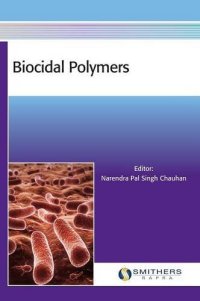
Ebook: Biocidal polymers
Author: Chauhan Narendra Pal Singh
- Tags: Antimicrobial polymers., Materials, Microbiology., Plastics, Additives., Polymers industry.
- Year: 2016
- Publisher: Smithers Rapra Technology
- Language: English
- pdf
Biocidal polymers are able to inhibit or kill microorganisms such as bacteria, fungi and protozoans. The advantages of antimicrobial polymers over conventional antimicrobial agents include their non-volatility, chemical stability, non-toxicity (difficult to permeate through the skin of animals), ability to prolong product life, increased efficiency and selectivity while minimising their environmental impact. Currently, there is an urgent requirement to develop a synthetic strategy involving different kinds of polymers whose potency against specific microorganisms is accompanied by less hazardous effects.
The main objective of this book is to provide detailed information on the synthesis, and mechanistic and technological aspects of synthetic and natural antimicrobial polymers including: cationic, amphiphilic, biomimetic, biodegradable chitin, chitosan, cellulose, pectin and so on, along with their chemical modification to produce polylactic acid- and polyethylene glycol-based copolymers, conducting polymers, antimicrobial plastics and rubber, functionalised antimicrobial polymers, polymer-metal nanocomposites, N-halamine-based polymers, peptides and so on. Methods of synthesising antimicrobial polymers, chemical modification, in addition to factors affecting their antimicrobial activities and major fields of applications are comprehensively described. Physico-chemical methods (nuclear magnetic resonance, Fourier-Transform infrared, confocal microscopy, differential scanning calorimetry, atomic force microscopy and scanning electron microscopy) are especially important in the study of the structure and other desired properties of monomers and polymers. Antimicrobial screening using diffusion and dilution methods, against several bacteria, fungi and protozoan, are also included.
This pioneering book is intended to be of general interest to microbiologists, biotechnologists, medical doctors, organic chemists, pharmacists, polymer scientists, food scientists and technologists. This book also offers a balanced, interesting and innovative perspective which is applicable to both academics and industry.